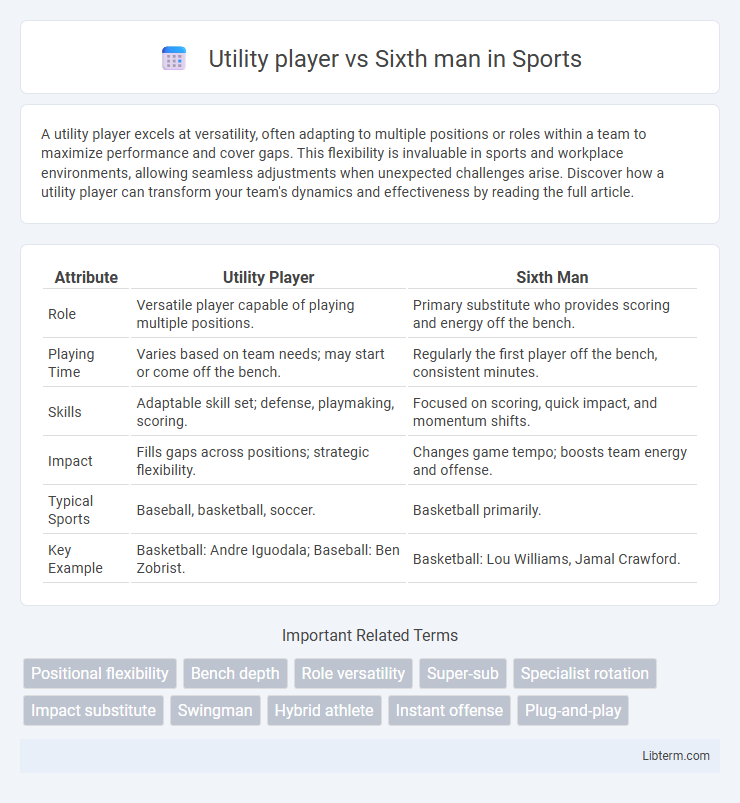A utility player excels at versatility, often adapting to multiple positions or roles within a team to maximize performance and cover gaps. This flexibility is invaluable in sports and workplace environments, allowing seamless adjustments when unexpected challenges arise. Discover how a utility player can transform your team's dynamics and effectiveness by reading the full article.
Table of Comparison
| Attribute | Utility Player | Sixth Man |
|---|---|---|
| Role | Versatile player capable of playing multiple positions. | Primary substitute who provides scoring and energy off the bench. |
| Playing Time | Varies based on team needs; may start or come off the bench. | Regularly the first player off the bench, consistent minutes. |
| Skills | Adaptable skill set; defense, playmaking, scoring. | Focused on scoring, quick impact, and momentum shifts. |
| Impact | Fills gaps across positions; strategic flexibility. | Changes game tempo; boosts team energy and offense. |
| Typical Sports | Baseball, basketball, soccer. | Basketball primarily. |
| Key Example | Basketball: Andre Iguodala; Baseball: Ben Zobrist. | Basketball: Lou Williams, Jamal Crawford. |
Utility Player vs Sixth Man: Key Differences
Utility players demonstrate versatility by effectively playing multiple positions on the court, contributing to various aspects of the game such as defense, playmaking, and scoring. Sixth men primarily serve as the first substitute off the bench, often specializing in offensive scoring or providing a spark to maintain team momentum. While both roles are crucial for team depth, utility players offer positional flexibility, whereas sixth men typically offer specialized impact during crucial game moments.
Defining the Utility Player in Team Sports
A utility player in team sports excels by adapting to multiple positions or roles, providing coaches with strategic flexibility and enhancing overall team dynamics. Unlike specialized players, utility players combine diverse skill sets that address varying game situations, making them invaluable assets during roster changes or injuries. Their versatility often leads to increased playing time and the ability to influence outcomes across different facets of the game.
The Sixth Man: Role and Impact in Basketball
The sixth man in basketball serves as the primary substitute who brings energy, scoring, and defensive versatility off the bench, often matching or exceeding the impact of starters. This role is strategically vital for maintaining team momentum and adjusting lineups mid-game, with many sixth men recognized for their ability to seamlessly integrate into various positions on the court. Their contributions significantly influence game outcomes by providing sustained offensive production and defensive stability during crucial moments.
Skills and Versatility: What Sets Utility Players Apart
Utility players excel in multiple positions on the basketball court, showcasing exceptional adaptability and a broad skill set that includes ball-handling, defense, and scoring. Unlike traditional sixth men, who primarily specialize as scoring threats off the bench, utility players provide coaches with strategic flexibility by seamlessly shifting roles based on game situations. Their ability to contribute effectively in various aspects--such as perimeter shooting, playmaking, and interior defense--distinguishes them as invaluable assets beyond just bench scoring.
Contribution and Value of the Sixth Man
The sixth man plays a crucial role by providing scoring, defense, and energy off the bench, often matching or exceeding starters' impact in key moments. Unlike a utility player who rotates through multiple positions, the sixth man specializes in maintaining team momentum and closing gaps when starters rest. This specialized contribution enhances overall team depth and strategic flexibility, increasing the Sixth Man's value in maintaining competitive advantage throughout the game.
Strategic Advantages of Utility Players
Utility players provide strategic flexibility by effectively covering multiple positions, allowing coaches to adapt lineups dynamically during games. Unlike sixth men who primarily serve as the first substitute to maintain scoring momentum, utility players enhance team depth and defensive schemes through their versatile skill sets. Their ability to shift roles enables more complex tactical adjustments, optimizing both offense and defense based on game flow.
The Sixth Man’s Influence on Game Momentum
The sixth man serves as a pivotal force in shifting game momentum by providing instant scoring, defensive versatility, and energy off the bench, often facing opposing starters to maintain or overturn leads. Unlike a utility player who adapts to various roles on the court, the sixth man consistently delivers high-impact performances in crucial moments, directly influencing team dynamics and morale. Their ability to spark runs and stabilize play during critical stretches frequently dictates the overall flow and outcome of the game.
Famous Utility Players and Sixth Men in Sports History
Utility players like Ben Zobrist and James Milner are renowned for their ability to excel in multiple positions, providing teams with tactical flexibility and depth across baseball and soccer. Sixth men, such as Jason Terry in basketball and Manu Ginobili, have historically contributed significant bench scoring and leadership, often changing the dynamic of games off the bench. These roles emphasize versatile skill sets that have established players as invaluable assets in sports history.
Selecting Between a Utility Player and a Sixth Man: Team Considerations
Selecting between a utility player and a sixth man depends on team needs and strategies, with utility players offering versatility by covering multiple positions while sixth men provide consistent scoring and energy off the bench. Teams prioritizing flexibility and injury coverage often prefer utility players for their ability to adapt to various roles. Conversely, squads emphasizing offensive production and bench strength lean towards sixth men who can reliably boost scoring during critical game stretches.
Future Trends: Evolving Roles in Modern Sports
Utility players and sixth men are increasingly valued for their versatility, enabling teams to adapt dynamically during gameplay and enhance strategic depth. Future trends indicate a growing emphasis on multi-skilled athletes who can seamlessly switch between positions, providing coaches with flexible rotation options and injury cover. Analytics-driven approaches are expected to further refine these roles, maximizing player efficiency and optimizing team performance in evolving competitive environments.
Utility player Infographic

 libterm.com
libterm.com